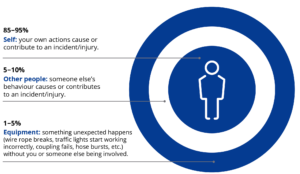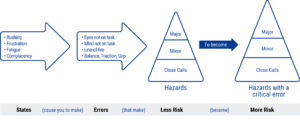Welcome back to the series on Paradigm Shifts.
This one is really about putting all of the concepts in the previous articles together to come up with what will hopefully be the most significant change in thinking so far.
As you may recall, in the first article we discussed hazards vs. hazardous energy, which includes kinetic energy and the importance of human error—specifically two critical errors: eyes not on task and mind not on task. Then in the next article we looked at our own personal risk pyramids and the three main sources of unexpected events.


For almost everyone, the Self-Area was over 95%. Then we looked at the counter-intuitive nature of risk assessment and why the worst injuries typically don’t come from the most dangerous things. But rather, the worst injuries happen when eyes and mind are both not on task. And we’ve talked about the four states: rushing, frustration, fatigue and complacency in general but not specifically in terms of how each state individually or by itself can cause critical errors. And we haven’t really discussed how the combination of states, like fatigue and complacency can be deadly (people falling asleep at the wheel). We have discussed, at least briefly, how developing or improving our safety-related habits can help “compensate” for complacency leading to mind not on task, but we really haven’t talked about the other three states (rushing, frustration, fatigue) and what to do about them.
So let’s go back to the three sources of unexpected events, and what would cause something to be unexpected in the Self-Area, like a mistake, a miscalculation, a misjudgement, etc. Since we are never trying to make mistakes like losing our balance or not seeing a red light, it’s always unexpected. Whereas with decisions like marrying someone or investing in the stock market we know that we might be making a mistake—so if things don’t work out it’s not totally unexpected. It might be totally unwanted, but it’s not like losing your balance and falling—when you didn’t see the cord or the spill… and you hit ground so fast you barely know what happened, or you stand up quickly and bang your head so hard you see stars or black out. And obviously, if you wake up asking, “What happened?” then it was totally unexpected. This is not to say that you can’t make a miscalculation about your speed on a curve or how long it will take to brake on the newly-wet pavement. However, the percentages of those where you miscalculated are relatively small compared to the ones where you didn’t even think about the wet pavement being slippery or a problem in the first place—so there was no calculation, or when you were distracted—so you didn’t see the curve until it was too late to slow down or too late to slow down “comfortably”.
The very nature of mistakes and errors makes them unexpected events, even though (somewhat ironically) we all know we make mistakes. And although some mistakes do turn out for the best, they are not the majority. Most produce unwanted consequences, which is why we all try not to make any mistakes—ever. Just like we’re never trying to get hurt… however, when you’re not moving or things aren’t moving around you, it’s hard to get hurt. You can still make mistakes—lots of mistakes—that waste your time or money, but the risk of accidental injury is pretty low.

However, once you start moving or walking and/or things start moving around you like cars and trucks, then some errors like eyes not on task and mind not on task could cause you to walk out in front of a moving car or into the line-of-fire. One or more of the first two critical errors could also cause you to lose your balance because you didn’t see the crack in the sidewalk.
So, as mentioned in previous articles, there are a total of—or only—four critical errors: eyes not on task, mind not on task, moving into or being in the line-of-fire or somehow losing your balance, traction or grip. Can you think of a time you’ve been hurt, in the Self-Area, when you were looking at what you were doing, thinking about what you were doing, you were aware of the line-of-fire or what could be coming at you, and you were at least conscious or thinking about what could cause you to lose your balance, traction or grip?
If you’re like most people, you can’t think of an exception—unless it’s sports related. And even then, the exceptions are rare. But that’s it. Only four critical errors that are involved in over 95% of all accidental injuries—whether they’re at work, at home or on the road.
However, as we have discussed, we are never trying to make any mistakes, whether they cause wasted time, wasted money or cause injuries. So, we have to look at what causes people to make mistakes or what causes people to make the most mistakes. However, when you ask this question, many people just say, “Lots of things…” but is it really “lots” or is it just a few? Because if it’s just a few then it’s much more manageable. So, thinking back to the Self-Area, can you think of a time you’ve been hurt when you weren’t rushing (or going faster than what’s normal for you), you weren’t frustrated, you weren’t overly tired or fatigued, and you hadn’t become so complacent that you just weren’t thinking about the hazards or amount of hazardous energy at that moment?
Chances are you don’t have an example or an exception for this one either, unless it was extreme joy or sorrow. Extreme sorrow, thankfully, is not something that we have to contend with every day. And extreme joy is not a problem at most workplaces. But rushing, frustration, fatigue and complacency are states that we do have to deal with on a regular basis—almost daily. And while you might be able to say, “Don’t rush”, it’s difficult to say, “And don’t ever be tired again either”. So eliminating these states or human factors from life or from work is not going to be possible. But there is some good news. Basically, there are only four states, and even though we can’t eliminate those four states, we can recognize the first three. We can tell when we are rushing because we have to make a conscious effort to go faster then what’s normal. We can easily recognize frustration, and we can recognize fatigue, which means we can use those states as a trigger to remind ourselves to keep our eyes on task and mind on task and to look for line-of-fire and things that would cause us to lose our balance, traction or grip. Or to put it another way, as soon as you realize you’re rushing, frustrated or fatigued you need to (quickly) “self-trigger”.
Self-triggering is the first critical error reduction technique. Basically it’s a two-step process: as soon as you “self-trigger” and come back to the moment, your first impulse or option should be to slow down, or calm down or get some rest/take a break. But since that is not always possible in the real world, then you need to make sure that you keep your eyes on task, that you keep your mind on task (and on the risk of what you’re doing), and that you look for and think about line-of-fire, and what could cause you to lose your balance, traction or grip. That is the second part of self-triggering. And as mentioned above, the key is to do it “quickly” or at least quickly enough to prevent the error.

Although it takes some time, if you get good with this skill, it’s incredibly efficient, it works really well in terms of preventing serious injuries and it doesn’t cost any money. But it’s not as simple as it seems. Or, as Kevin Cobb first said, one of first SafeStart’s Consultants, “Knowing that rushing is a risk isn’t much of a trick. But knowing that rushing is a risk—when you’re in a rush—that’s a heck of a trick.” And this leads us into the neuroscience or how do we actually train our sub-conscious mind, so that we will be able to self-trigger quickly enough (more on that next issue).
For now, the paradigm shift in this article, or the change in perspective, as mentioned at the beginning, is really just the summation or cumulative result of putting all the previous concepts together to come up with the technique or concept of learning how to self-trigger on rushing, frustration and fatigue, so you don’t make a critical error.


SHARE THIS ARTICLE!